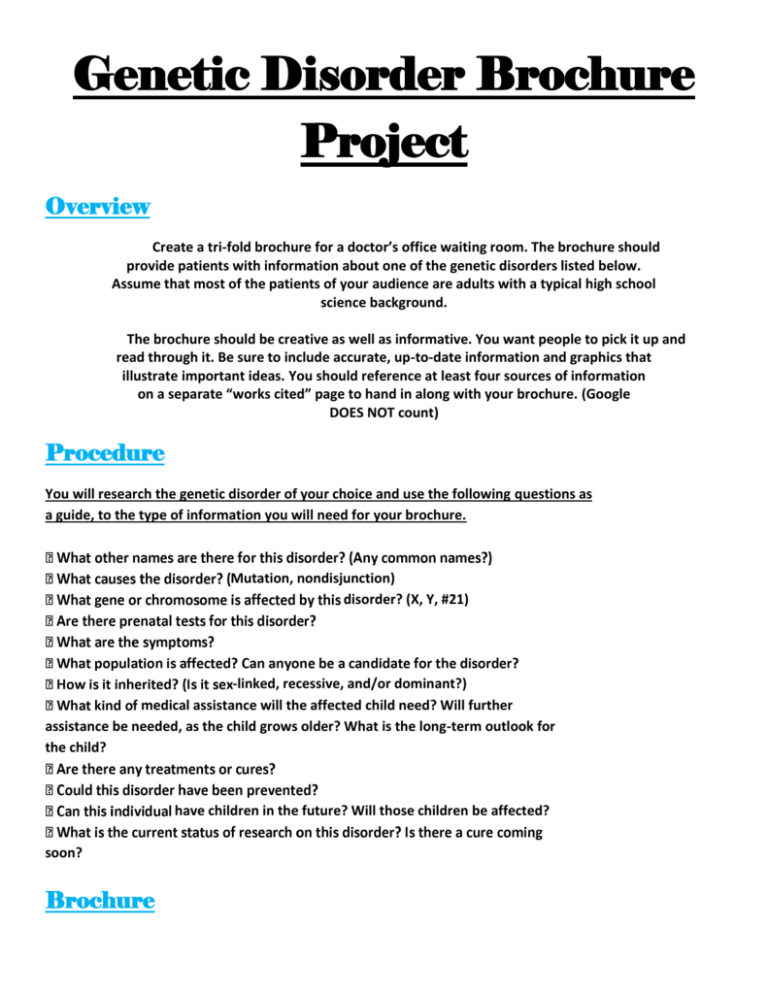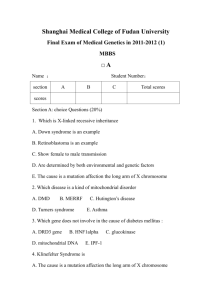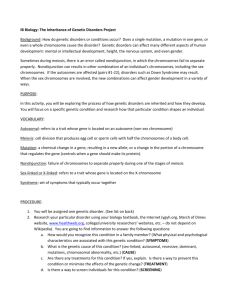Genetic Disorder Brochure Project
advertisement

Genetic Disorder Brochure Project Overview Create a tri-fold brochure for a doctor’s office waiting room. The brochure should provide patients with information about one of the genetic disorders listed below. Assume that most of the patients of your audience are adults with a typical high school science background. The brochure should be creative as well as informative. You want people to pick it up and read through it. Be sure to include accurate, up-to-date information and graphics that illustrate important ideas. You should reference at least four sources of information on a separate “works cited” page to hand in along with your brochure. (Google DOES NOT count) Procedure You will research the genetic disorder of your choice and use the following questions as a guide, to the type of information you will need for your brochure. Mutation, nondisjunction) disorder? (X, Y, #21) -linked, recessive, and/or dominant?) medical assistance will the affected child need? Will further assistance be needed, as the child grows older? What is the long-term outlook for the child? have children in the future? Will those children be affected? soon? Brochure After researching the disorder, make an informational pamphlet that could be given to patients. The pamphlet must be no larger than 8.5 x 11 unfolded. This brochure should be of professional quality. It must fully inform the reader of all issues pertaining to the genetic disorder. Again, use the questions provided to guide your research. Your brochure will be graded based on accuracy, completeness, and creativity. Visual representations (pictures, graphs, etc.) should be incorporated into the brochure. Give credit for graphics you did not make. Works Cited Page You will need to prepare, on a separate sheet, a works cited page that identifies all sources used to make the brochure. At least four sources are required for this project. More than four is acceptable, and encouraged! (Be sure to use proper format; do not just list websites, list author, title, date, etc.) Here is an example of how you record your reference: Huntington’s disease Society of America website, Living with Huntington’s, article by Pat Pillis. Possible Internet Resources (use google.com to find other sites) Online Mendelian Inheritance in Man Center for Disease Control Genetic Information International Birth Defects Information Systems National Center for Biotechnology Information Genetic Alliance Howard Hughes Medical Institute National Institute of Health Office of Rare Diseases Genetics Education Center LIST OF GENETIC DISORDERS Here are some suggested genetic disorders; others may be approved: Achondroplasia - most common genetic cause of dwarfism Achromatopsia - visual acuity loss, colorblindness, light sensitivity, and nystagmus Albinism - little or no production of melanin in hair, skin, and iris of the eyes Alzheimer’s Disease - most common form of dementia Angelman Syndrome - intellectual and developmental delays, severe speech impairment and problems in movement and balance, recurrent seizures and small heads Bardet-Biedl Syndrome - obesity, polydactyly, deterioration of rod and cone cells, mental retardation and defect in the gonads, and kidney disease Barth Syndrome - mutations or alterations in the BTHS gene, heart defects, poor skeletal musculature, short stature, mitochondrial abnormalities, and deficiency of white blood cells Bloom Syndrome - high frequency of breaks and rearrangements in the chromosomes Canavan Disease - steady damage to nerve cells in the brain Charcot-Marie-Tooth disease - touch sensation and loss of muscle tissue Color Blindness - inability of differentiating among certain colors Cri-du-Chat Syndrome - spontaneous deletion of a segment of chromosome 5 during formation of egg or sperm or during early stages of fetal development Cystic Fibrosis - autosomal recessive disorder secreting mucus and sweat Down Syndrome - abnormal cell division of chromosome 21 Duchenne Muscular Dystrophy - rapidly gradual muscle weakness and damaged muscular tissue in the pelvis and legs Fragile X Syndrome - inherited form of mental retardation Hailey-Hailey Disease - blistering rashes on body folds Hemophilia - body’s inability to control bleeding (interior or exterior, or both) Huntington’s Disease - production of a faulty protein instead of the normal “huntingtin” protein Jackson-Weiss Syndrome - foot abnormalities and premature fusion of bones in the skull Klinefelter Syndrome - abnormal testicular evolution and decreased fertility Krabbe Disease - mutation in the GALC gene Langer-Giedion Syndrome - deletion or mutation of at least two genes on chromosome 8 Lowe Syndrome - physical and mental retardation Marfan Syndrome - genetic disorder of the connective tissue Muscular Dystrophy - progressive weakening and breaking down of muscle fibers Myotonic Dystrophy - wasting of the muscles, cataracts, heart conduction defects, endocrine changes, and myotonia Nail-Patella Syndrome - lack of nail and knee caps Neurofibromatosis - development of tumors along the different nerves and evolution of non-nervous tissues, like skin and bones Noonan Syndrome - heart malformations, short stature, characteristic facial features, impaired blood clotting, and indentation of the chest Osteogenesis Imperfecta - weakened muscles, brittle bones, curved spine, and impaired hearing Parkinson’s Disease - impairment of the central nervous system Patau Syndrome - non-disjunction of chromosome 13 Phenylketonuria - mental retardation, seizures, or brain damage Porphyria - accumulation of porphyrin or its precursors in the body Prune Belly Syndrome - presence of mass of wrinkled skin on the abdomen Retinoblastoma - cancer of the retina Rett Syndrome - decreased rate of head growth, small hands and feet, disabilities related to learning communication, coordination and speech Russell Silver Syndrome - poor growth, low birth weight, short height, and differences in the size of the two sides of the body Sanfilippo Syndrome - deficiency in one of the enzymes needed to break down the glycosaminoglycan heparan sulfate Schizencephaly - abnormal development of the brain Shwachman Syndrome - exocrine pancreatic insufficiency, bone marrow dysfunction, skeletal abnormalities, and short stature Sickle Cell Anemia - blood disorder causing sickling of the red blood cells Smith-Lemli-Opitz Syndrome - distinctive facial features, small head size (microcephaly), intellectual disability or learning problems, and behavioral problems Spina Bifidia - malformations of the spinal cord TAR Syndrome - absence of the radius bone in the forearm and reduced platelet count Tay-Sachs Disease - damage of the nerve cells in brain and spinal cord Turner Syndrome - lack of either one whole or a part of an X chromosome Usher Syndrome - deafness and progressive loss of vision Von Hippel-Lindau Syndrome - formation of tumors and fluid-filled sacs (cysts) in different parts of the body Waardenburg Syndrome - varying degrees of deafness and changes in hair and skin pigmentation Wilson’s Disease - body’s inability to get rid of excess copper in the body Xeroderma Pigmentosum - inability of the DNA to repair damage caused due to ultraviolet rays XXXX Syndrome - two extra copies of the X chromosome in females XXX Syndrome - extra copy of the X chromosome in females XYY Syndrome - extra copy of the Y chromosome in males







